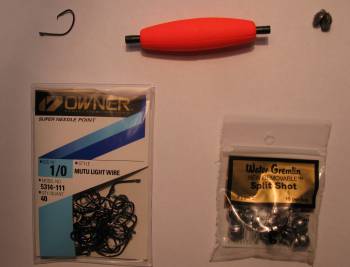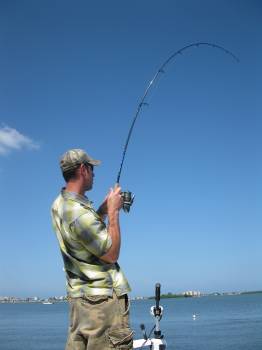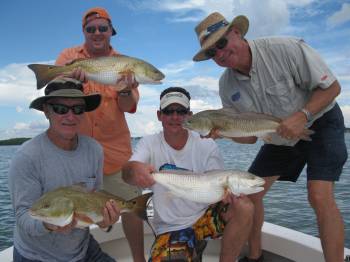 Tampa Fishing for redfish is best from early March through the end of October, although fish are available year round.
Tampa Fishing for redfish is best from early March through the end of October, although fish are available year round.
Their abundance and willingness to eat make them the “bread and butter” species for Tampa inshore fishing guides. As with many shallow water fish, targeting days with the strongest tides is best, so reference your tide charts before heading out on the water. Tackle typically used to pursue redfish is comprised of a a seven and a half foot, medium action, spinning rod matched with a reel designed for twenty to thirty pound 30 lbs braided line. Start your day by securing a variety of baits. When available, whitebait (pilchards) are always a top choice, but are not essential for catching redfish. Their primary inshore food sources are small crustaceans like crabs and shrimp, so large shrimp are also an excellent option. If you are not expert at throwing a cast net for whitebait and/or not in the neighborhood of a tackle store that sells shrimp however, small whole pinfish or grunts and cut baits will do the job. The best cut bait seems to be ladyfish or mullet, but Spanish mackerel to lizardfish will work. Since redfish make a living off of eating small crabs, they rarely refuse a large soft chunk of protein like cut bait.
Learning where the redfish are in your area is simply a function of being on the water a lot, or having a good friend who is, but certain environments are much more likely to hold redfish than others. Residential docks, oyster bars, grass flats and mangrove shorelines would be the key areas prospected on most Tampa fishing charters. Docks are the mainstay of many redfish anglers for two reasons. First, once a dock is located that holds redfish, it typically continues to do so, year after year, unless something about the structure changes. Second, docks fish very “fast”, that is to say that a bait cast under a dock is typically eaten within the first 5 minues if a redfish is there. Therefore, a redfisherman who both has a good repetoire of docks and fishes hard is likely to find fish on almost every trip. The biggest draw back to dock fishing is that large redfish will occasionally get back into the structure and break off. The best tides for dock fishing would be the two hours before and after the high tide but, unlike some of the other areas to be discussed, fish can be caught off docks on the lower phases of the tide, as long as enough water remains. The best rigging for dock fishing would be a four foot length of 30 lbs flourocarbon leader, tied to a quality 1/0 or 2/0 hook, like the Mutu Light Circle Hook manufactured by Owner. Use a large split shot, PSS2 size, to aid in casting accuracy and also to hold the bait in place. A free floating live or dead bait will quickly find a dock pole so the sinker is a critical ingredient. Any of the above mentioned baits will be effective but make sure to trim a pinfish or grunts tail before throwing it under a dock so it’s ability to swim around a dock pole is minimized.


Oyster bars are another location that redfish frequent, and for obvious reasons. Their favorite dinner resides there. Oyster bars are littered with the small, black crabs that redfish love. Local Tampa fishing guides fish these bars primarily on the higher phases of the tide as many bars are out of water on the lower tides. Once the water rises up over the bar, redfish will usually take up a position around the perimeter of the bar…just off of the oysters in the sandy transition area between the oysters and sea grass. This area appears as a secondary yellow ring around the darker colored oyster bar. Baits should be cast into this area. If split shots are used, make sure to cast into the the transition area and not onto the bar itself as the weight will drop down into the oysters and become snagged. If the tide is several feet over the bar, baits can be fished with a “peg bobber” just off the bottom so that they’ll float over the actual bar itself. If an oyster bar stretches down a length of shoreline, and the wind or current are running parallel to that shoreline, a bobber may be the best approach as it will allow the angler to drift the full length of the bar on one cast. Live baits are usually a bit more effective when bobber fishing.
The largest schools of redfish are usually found out in the open grass flats or along mangrove shorelines. Prime grass flats will usually be littered with sand holes or depressions. On the low tides, redfish will drop into the deepest of these and wait for the water to flush back up onto the flats. At times, these potholes produce somewhat of a “fishbowl effect”, with multiple fish stacking up in one or two potholes. As the tide returns, fish tend to move shoreward, either into potholes closer to land or clean up into the mangroves. On the lowest tides, these fish can be seen tailing on the flats as they move towards the shoreline, dining along the way. As the fish stops to eat, it noses down into the grass and it’s tail pops up. Some Tampa fishing guides will follow these fish all the way in, casting unweighted shrimp to these cruising fish as they work their way shoreward. If fishing single, larger, potholes on the flats, baits can be weighted and tossed into the hole. On flats with numerous potholes, use a bobber and set it so that the bait is six inches off the bottom. Next, position the boat upwind of the target area and cast to the closest pothole. Feed out line to allow this bait to drift over multiple potholes until the area is effectively covered. If a fish is hooked in one particular pothole, expect others in that same area.
 If the water is high enough so that there is several feet of water right in against the mangroves, redfish will move right up into “the bushes”. Redfish can actually be “lost to the mangroves” on extremely high tides as they move so deep into the mangroves that they aren’t reachable. In cases like this, fishing can be excellent an hour or two after the high tide as fish come pouring back out. As a general rule however, fishing mangrove shorelines is best on the highest phases of the tide. Mangroves provide a good food supply, protection from dolphin and sharks, and in the summer, cover from the hot sun. Many Tampa fishing charters up into the mangroves result in a variety of wildlife sightings which might include numerous sea birds, sharks, porpoises, and even manatees. The best fishing locations are deeper mangrove points that get good current flow. Most points on a mangrove shoreline will have oyster bars on them as well, providing an additional food source. If there are pockets or caves along these points, look to cast back up into these as there are days when the fish won’t want to come out of the mangroves to eat a bait. Most Tampa Area fishing guides will cast for customers in this situation unless the customer has exceptionally good casting ability. By putting a bait right into a mangrove cave, chances for hooking up are improved. Any deep areas along a mangrove shorelines, such as a creek mouth, represents another good area to try. In this shallow water environment, a foot of depth is significant so look for subtle drop offs and holes and expect to find fish there. Whether fishing potholes in the flats or along the mangroves, fish are usually found in groups of several to twenty fish, although there will be days when schools of several hundred fish are present and fish are hooked literally on every cast…the ideal Tampa fishing charter. As with longer shoreline oyster bars, if the angler is interested in prospecting a stretch of mangroves and the wind or tide are running parallel to shore, a bobbered pinfish or whitebait cast right up against the mangroves and allowed to drift along the shoreline can be very effective. Line should be mended in such a way as to keep the bait within a foot or two of the mangroves. If “plugging” the caves and holes in the mangroves, it’s best to use a good sized split shot, both to improve casting accuracy and to hold the bait in place so that it doesn’t drift into the mangrove roots down current.
If the water is high enough so that there is several feet of water right in against the mangroves, redfish will move right up into “the bushes”. Redfish can actually be “lost to the mangroves” on extremely high tides as they move so deep into the mangroves that they aren’t reachable. In cases like this, fishing can be excellent an hour or two after the high tide as fish come pouring back out. As a general rule however, fishing mangrove shorelines is best on the highest phases of the tide. Mangroves provide a good food supply, protection from dolphin and sharks, and in the summer, cover from the hot sun. Many Tampa fishing charters up into the mangroves result in a variety of wildlife sightings which might include numerous sea birds, sharks, porpoises, and even manatees. The best fishing locations are deeper mangrove points that get good current flow. Most points on a mangrove shoreline will have oyster bars on them as well, providing an additional food source. If there are pockets or caves along these points, look to cast back up into these as there are days when the fish won’t want to come out of the mangroves to eat a bait. Most Tampa Area fishing guides will cast for customers in this situation unless the customer has exceptionally good casting ability. By putting a bait right into a mangrove cave, chances for hooking up are improved. Any deep areas along a mangrove shorelines, such as a creek mouth, represents another good area to try. In this shallow water environment, a foot of depth is significant so look for subtle drop offs and holes and expect to find fish there. Whether fishing potholes in the flats or along the mangroves, fish are usually found in groups of several to twenty fish, although there will be days when schools of several hundred fish are present and fish are hooked literally on every cast…the ideal Tampa fishing charter. As with longer shoreline oyster bars, if the angler is interested in prospecting a stretch of mangroves and the wind or tide are running parallel to shore, a bobbered pinfish or whitebait cast right up against the mangroves and allowed to drift along the shoreline can be very effective. Line should be mended in such a way as to keep the bait within a foot or two of the mangroves. If “plugging” the caves and holes in the mangroves, it’s best to use a good sized split shot, both to improve casting accuracy and to hold the bait in place so that it doesn’t drift into the mangrove roots down current.
A few additional tips that wil help anglers catch redfish in the Tampa Bay Area are the following. First, in locations known to hold redfish, look for schools of large mullet. If redfish are in the vicinity, they are likely to be traveling with the mullet. Second, fish the shadows when it’s hot as, like most animals, redfish will seek the most comfortable environments in the heat of summer. Docks and mangroves provide this shade. Third, make sure to bring cut bait of some kind on every trip. It’s easy to cast very accurately and for great distance and is rarely refused by a hungry redfish. To view additional redfish photos, click here. Good luck and good fishing.
